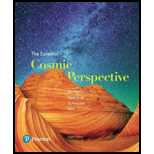
Concept explainers
Part a
Whether the following Hypothetical observations can be explained by the Big Bang theory or not? Should we abandon the Big Bang theory or revision of Big Bang would be able to explain?
A cluster with an age of 15 billion years.
Part b
Whether the following Hypothetical observations can be explained by the Big Bang theory or not? Should we abandon the Big Bang theory or revision of Big Bang would be able to explain?
A galaxy with an age of 10 million years.
Part c
Whether the following Hypothetical observations can be explained by the Big Bang theory or not? Should we abandon the Big Bang theory or revision of Big Bang would be able to explain?
A galaxy at a distance of 10 billion light years whose spectrum is blue-shifted.
Part d
Whether the following Hypothetical observations can be explained by the Big Bang theory or not? Should we abandon the Big Bang theory or revision of Big Bang would be able to explain?
A galaxy containing 90% hydrogen and 10% Helium.
Part e
Whether the following Hypothetical observations can be explained by the Big Bang theory or not? Should we abandon the Big Bang theory or revision of Big Bang would be able to explain?
Evidence of increase in temperature of cosmic microwave background with time.
Want to see the full answer?
Check out a sample textbook solution
Chapter 17 Solutions
The Essential Cosmic Perspective (8th Edition)
- An infinitely long line of charge has linear charge density 4.00×10−12 C/m . A proton (mass 1.67×10−−27 kg, charge +1.60×10−19 C) is 18.0 cm from the line and moving directly toward the line at 4.10×103 m/s . How close does the proton get to the line of charge?arrow_forwardat a certain location the horizontal component of the earth’s magnetic field is 2.5 x 10^-5 T due north A proton moves eastward with just the right speed so the magnetic force on it balances its weight. Find the speed of the proton.arrow_forwardExample In Canada, the Earth has B = 0.5 mT, pointing north, 70.0° below the horizontal. a) Find the magnetic force on an oxygen ion (O) moving due east at 250 m/s b) Compare the |FB| to |FE| due to Earth's fair- weather electric field (150 V/m downward).arrow_forward
- Three charged particles are located at the corners of an equilateral triangle as shown in the figure below (let q = 2.20 µC, and L = 0.810 m). Calculate the total electric force on the 7.00-µC charge. What is the magnitude , what is the direction?arrow_forward(a) Calculate the number of electrons in a small, electrically neutral silver pin that has a mass of 9.0 g. Silver has 47 electrons per atom, and its molar mass is 107.87 g/mol. (b) Imagine adding electrons to the pin until the negative charge has the very large value 2.00 mC. How many electrons are added for every 109 electrons already present?arrow_forward(a) Calculate the number of electrons in a small, electrically neutral silver pin that has a mass of 13.0 g. Silver has 47 electrons per atom, and its molar mass is 107.87 g/mol.arrow_forward
- 8 Two moving charged particles exert forces on each other because each creates a magnetic field that acts on the other. These two "Lorentz" forces are proportional to vix (2 xr) and 2 x (vi x-r), where is the vector between the particle positions. Show that these two forces are equal and opposite in accordance with Newton's third law if and only if rx (vi × 2) = 0.arrow_forward6 The force = +3 + 2k acts at the point (1, 1, 1). Find the torque of the force about (a) (b) the point (2, -1, 5). Careful about the direction of ŕ between the two points. the line = 21-+5k+ (i-+2k)t. Note that the line goes through the point (2, -1, 5).arrow_forward5 Find the total work done by forces A and B if the object undergoes the displacement C. Hint: Can you add the two forces first?arrow_forward
- 1 F2 F₁ -F₁ F6 F₂ S A Work done on the particle as it moves through the displacement is positive. True False by the force Farrow_forwardA student measuring the wavelength produced by a vapour lamp directed the lightthrough two slits with a separation of 0.20 mm. An interference pattern was created on the screen,3.00 m away. The student found that the distance between the first and the eighth consecutive darklines was 8.0 cm. Draw a quick picture of the setup. What was the wavelength of the light emittedby the vapour lamp?arrow_forwardA ball is tied to one end of a string. The other end of the string is fixed. The ball is set in motion around a vertical circle without friction. At the top of the circle, the ball has a speed of ; = √√ Rg, as shown in the figure. At what angle should the string be cut so that the ball will travel through the center of the circle? The path after string is cut Rarrow_forward
 College PhysicsPhysicsISBN:9781305952300Author:Raymond A. Serway, Chris VuillePublisher:Cengage Learning
College PhysicsPhysicsISBN:9781305952300Author:Raymond A. Serway, Chris VuillePublisher:Cengage Learning University Physics (14th Edition)PhysicsISBN:9780133969290Author:Hugh D. Young, Roger A. FreedmanPublisher:PEARSON
University Physics (14th Edition)PhysicsISBN:9780133969290Author:Hugh D. Young, Roger A. FreedmanPublisher:PEARSON Introduction To Quantum MechanicsPhysicsISBN:9781107189638Author:Griffiths, David J., Schroeter, Darrell F.Publisher:Cambridge University Press
Introduction To Quantum MechanicsPhysicsISBN:9781107189638Author:Griffiths, David J., Schroeter, Darrell F.Publisher:Cambridge University Press Physics for Scientists and EngineersPhysicsISBN:9781337553278Author:Raymond A. Serway, John W. JewettPublisher:Cengage Learning
Physics for Scientists and EngineersPhysicsISBN:9781337553278Author:Raymond A. Serway, John W. JewettPublisher:Cengage Learning Lecture- Tutorials for Introductory AstronomyPhysicsISBN:9780321820464Author:Edward E. Prather, Tim P. Slater, Jeff P. Adams, Gina BrissendenPublisher:Addison-Wesley
Lecture- Tutorials for Introductory AstronomyPhysicsISBN:9780321820464Author:Edward E. Prather, Tim P. Slater, Jeff P. Adams, Gina BrissendenPublisher:Addison-Wesley College Physics: A Strategic Approach (4th Editio...PhysicsISBN:9780134609034Author:Randall D. Knight (Professor Emeritus), Brian Jones, Stuart FieldPublisher:PEARSON
College Physics: A Strategic Approach (4th Editio...PhysicsISBN:9780134609034Author:Randall D. Knight (Professor Emeritus), Brian Jones, Stuart FieldPublisher:PEARSON





